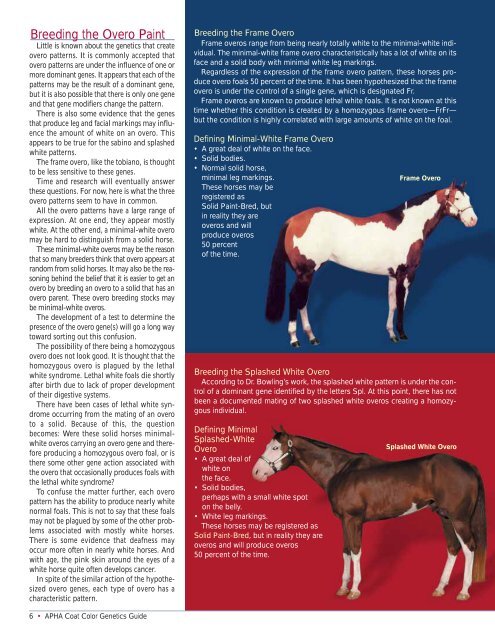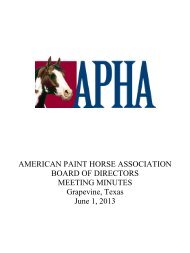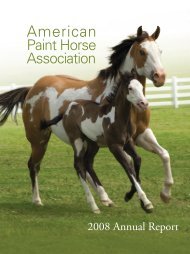Coat Color Genetics - Press - American Paint Horse Association
Coat Color Genetics - Press - American Paint Horse Association
Coat Color Genetics - Press - American Paint Horse Association
You also want an ePaper? Increase the reach of your titles
YUMPU automatically turns print PDFs into web optimized ePapers that Google loves.
Breeding the Overo <strong>Paint</strong><br />
Little is known about the genetics that create<br />
overo patterns. It is commonly accepted that<br />
overo patterns are under the influence of one or<br />
more dominant genes. It appears that each of the<br />
patterns may be the result of a dominant gene,<br />
but it is also possible that there is only one gene<br />
and that gene modifiers change the pattern.<br />
There is also some evidence that the genes<br />
that produce leg and facial markings may influence<br />
the amount of white on an overo. This<br />
appears to be true for the sabino and splashed<br />
white patterns.<br />
The frame overo, like the tobiano, is thought<br />
to be less sensitive to these genes.<br />
Time and research will eventually answer<br />
these questions. For now, here is what the three<br />
overo patterns seem to have in common.<br />
All the overo patterns have a large range of<br />
expression. At one end, they appear mostly<br />
white. At the other end, a minimal-white overo<br />
may be hard to distinguish from a solid horse.<br />
These minimal-white overos may be the reason<br />
that so many breeders think that overo appears at<br />
random from solid horses. It may also be the reasoning<br />
behind the belief that it is easier to get an<br />
overo by breeding an overo to a solid that has an<br />
overo parent. These overo breeding stocks may<br />
be minimal-white overos.<br />
The development of a test to determine the<br />
presence of the overo gene(s) will go a long way<br />
toward sorting out this confusion.<br />
The possibility of there being a homozygous<br />
overo does not look good. It is thought that the<br />
homozygous overo is plagued by the lethal<br />
white syndrome. Lethal white foals die shortly<br />
after birth due to lack of proper development<br />
of their digestive systems.<br />
There have been cases of lethal white syndrome<br />
occurring from the mating of an overo<br />
to a solid. Because of this, the question<br />
becomes: Were these solid horses minimalwhite<br />
overos carrying an overo gene and therefore<br />
producing a homozygous overo foal, or is<br />
there some other gene action associated with<br />
the overo that occasionally produces foals with<br />
the lethal white syndrome?<br />
To confuse the matter further, each overo<br />
pattern has the ability to produce nearly white<br />
normal foals. This is not to say that these foals<br />
may not be plagued by some of the other problems<br />
associated with mostly white horses.<br />
There is some evidence that deafness may<br />
occur more often in nearly white horses. And<br />
with age, the pink skin around the eyes of a<br />
white horse quite often develops cancer.<br />
In spite of the similar action of the hypothesized<br />
overo genes, each type of overo has a<br />
characteristic pattern.<br />
6 • APHA <strong>Coat</strong> <strong>Color</strong> <strong>Genetics</strong> Guide<br />
Breeding the Frame Overo<br />
Frame overos range from being nearly totally white to the minimal-white individual.<br />
The minimal-white frame overo characteristically has a lot of white on its<br />
face and a solid body with minimal white leg markings.<br />
Regardless of the expression of the frame overo pattern, these horses produce<br />
overo foals 50 percent of the time. It has been hypothesized that the frame<br />
overo is under the control of a single gene, which is designated Fr.<br />
Frame overos are known to produce lethal white foals. It is not known at this<br />
time whether this condition is created by a homozygous frame overo—FrFr—<br />
but the condition is highly correlated with large amounts of white on the foal.<br />
Defining Minimal-White Frame Overo<br />
• A great deal of white on the face.<br />
• Solid bodies.<br />
• Normal solid horse,<br />
minimal leg markings.<br />
These horses may be<br />
registered as<br />
Solid <strong>Paint</strong>-Bred, but<br />
in reality they are<br />
overos and will<br />
produce overos<br />
50 percent<br />
of the time.<br />
Breeding the Splashed White Overo<br />
According to Dr. Bowling’s work, the splashed white pattern is under the control<br />
of a dominant gene identified by the letters Spl. At this point, there has not<br />
been a documented mating of two splashed white overos creating a homozygous<br />
individual.<br />
Defining Minimal<br />
Splashed-White<br />
Overo<br />
• A great deal of<br />
white on<br />
the face.<br />
• Solid bodies,<br />
perhaps with a small white spot<br />
on the belly.<br />
• White leg markings.<br />
These horses may be registered as<br />
Solid <strong>Paint</strong>-Bred, but in reality they are<br />
overos and will produce overos<br />
50 percent of the time.<br />
Frame Overo<br />
Splashed White Overo




